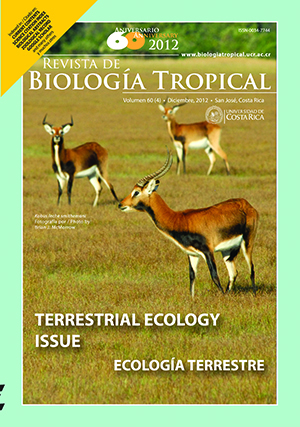Abstract
Growth and survival of the green mussel P. viridis (Bivalvia: Mytilidae) in bottom culture conditions in Turpialito, Golfo de Cariaco, Venezuela. Mussels represent one of the most important mol- lusk species for culture activities around the world, and their growth may depend on the culture system used and locality. In this study, we evaluated the growth of Perna viridis in bottom culture to test its performance when using natural food, and to decide its use as a culture species in the Gulf of Cariaco. For this, mussel seeds (35.81±1.41mm in length) were obtained in the locality of Guaca (North coast of Sucre state) and transferred to the Hydrobiological Station of Turpialito, Gulf of Cariaco, Sucre state, Venezuela, where they were planted in “Spanish baskets “ to evaluate their growth between July 2007 and February 2008. Monthly survival was determined and the maximum shell length, dry mass of muscle and remains tissues of the gonad. The environmental parameters (water temperature, salinity, dissolved oxygen, chlorophyll a, total seston and organic fraction), in the cultivation area were determined every 15 days. Monthly measurements were made of proteins, lipids and carbohydrates to seston. During the entire study the mussels showed continued growth, ultimately reaching a maximum length of 78.7±4.43mm. However, the growth rate of the dry mass of somatic (muscle, other tissue) and reproductive tissues showed variability throughout the study, and observed a significant increase by the end of the experiment. The observed variations in the growth rate of the reproductive tissue mass depended on the reserves accumulated and food offered by the environment. The organic seston throughout the experience showed an independence of temperature and chlorophyll a values; this one maintained values above 1mg/L, thus forming the main food resource for mussels. The high content of proteins, lipids and carbohydrates observed in the seston at the end of the study, might be mainly associated with coastal upwelling, which provides a great food contribution of phytoplankton and organic type. The high survival rate (>80%), increase in the length of the shell and the high gonad production, suggests an excellent physiological condition of P. viridis, related to the availability and quality of food particularly the organic type present in the medium. We concluded that the bottom culture can provide an alternative aquaculture production in the Gulf of Cariaco.Comments

This work is licensed under a Creative Commons Attribution 4.0 International License.
Copyright (c) 2012 Revista de Biología Tropical
Downloads
Download data is not yet available.






